This Special Release presents data on volume and value of production of fisheries in the province of Cavite for the third quarter of 2024. Figures are based on the preliminary results of the tabulated data from the Quarterly Fisheries Survey, Fisheries Statistics Division (FSD).
Volume of Fisheries Production
CALABARZON region recorded a total fisheries production of 46,906.94 metric tons in the third quarter of 2024, showing an increase of 19.13 percent from 39,373.06 metric tons in the same period last year. Cavite declined to 14.14 percent in the third quarter of 2024 from 3,994.80 metric tons in the same period in 2023 to 3,430 metric tons in the third quarter of 2024. (Refer to Table 1 for details.)
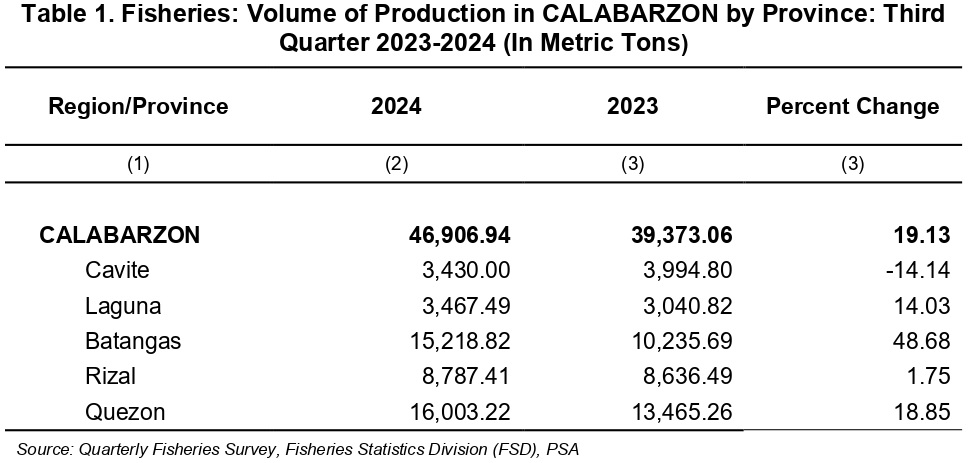
The province of Cavite shares 7.31 percent in the total fisheries production of the region despite experiencing the production decrease. Quezon had the highest shares with 34.12 percent followed by the Province of Batangas which contributed 32.44 percent. (Refer to Figure 1 for details.)
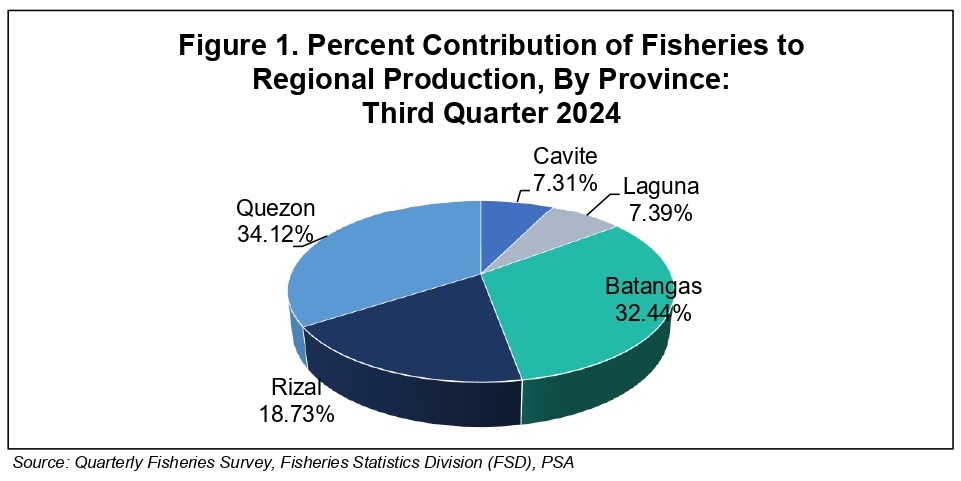
Volume of Fisheries Production by Sector
The total volume of production of fisheries in all sectors in CALABARZON shows growth from the third quarter of 2023 and 2024. However, most of the production in fisheries sectors in the province of Cavite declined. Inland and aquaculture fisheries recorded the highest decrease with 89.84 percent and 66.03 percent, respectively. Municipal fisheries, on the other hand, raised 4.46 percent increased of production, amounting to 1,654.10 metric tons in the third quarter of 2024. (Refer to Table 2 for details.)
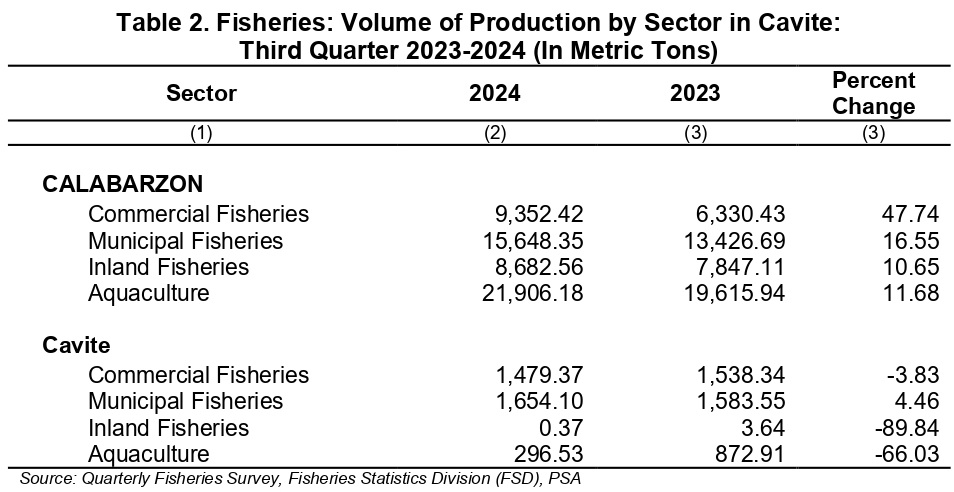
Likewise, during the third quarter of 2024, the top contributor among the sectors in Cavite province was from municipal fisheries at 48.22 percent, followed by commercial fisheries with least shared 43.13 percent, aquaculture at 8.65 percent, and inland fisheries with 0.01 percent. (Refer to Figure 2 for details.)
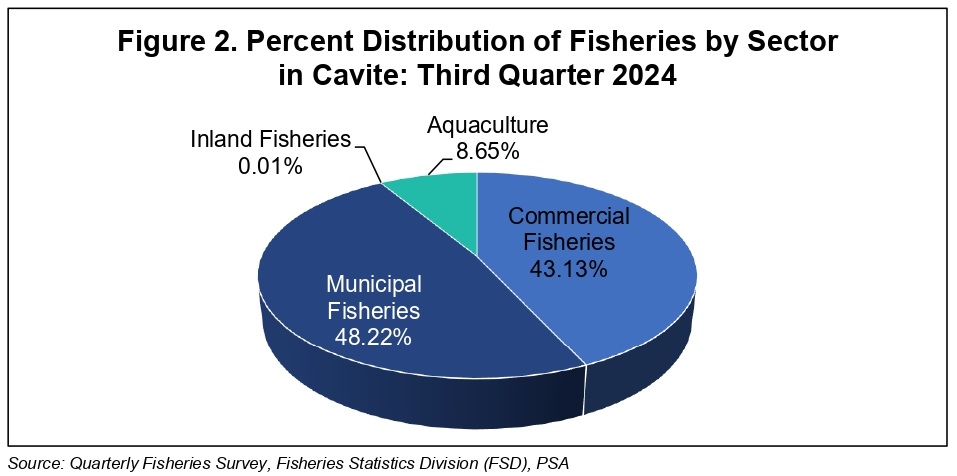
Value of Production by Sector in Cavite
Cavite province experienced production value’s decrease in all sectors, showing 19.80 percent, from 678.95 million pesos to 544.52 million pesos in the same quarter of 2023. Inland fisheries had the biggest decline in value at 88.50 percent followed by aquaculture which recorded 11.37 million pesos decreased by 64.23 percent. Same as the commercial and municipal fisheries declined at 13.32 percent and 21.44 percent, respectively. (Refer to Table 3 for details.)
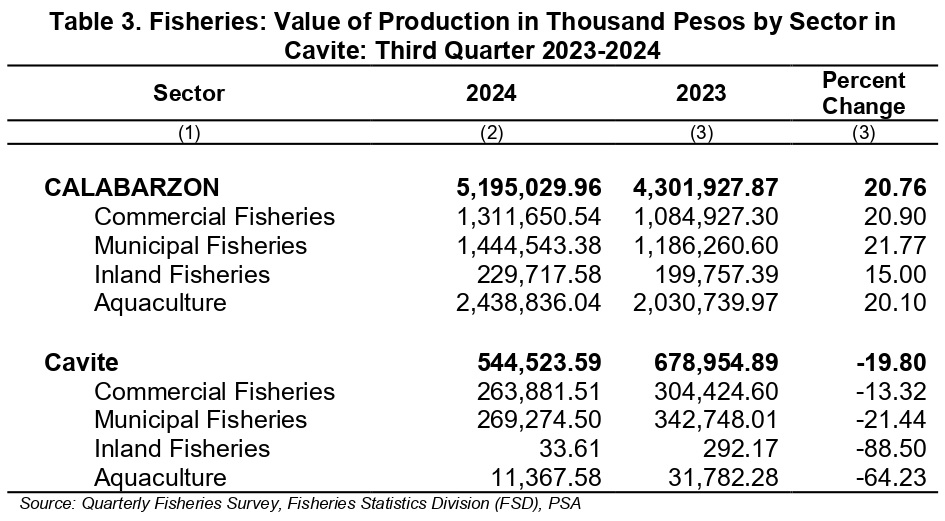
Volume of Aquaculture Production
The volume of production in aquaculture by ecosystem type increased by 11.68 percent for the whole CALABARZON region. It was recorded at 21,906.18 metric tons in the third quarter of 2024 compared to last year’s production at 19,615.94 metric tons. The increase was mainly attributed to the freshwater fishpond with 102.00 percent or about 92.88 metric tons and marine cage with an increase of 11.67 percent.
On the other hand, Cavite’s aquaculture total production in the third quarter of 2024 was estimated at 296.53 metric tons. The production decreased by 66.03 percent from 872.91 metric tons in the same quarter of 2023. Some of the aquafarm type had no harvest specifically in brackishwater fishpond, brackishwater pen and marine cage. Freshwater fishpond (0.22 metric tons), oyster (19.77 metric tons), and mussel (276.54 metric tons) recorded an output for the same reference period of 2024. (Refer to Table 4 for details.)
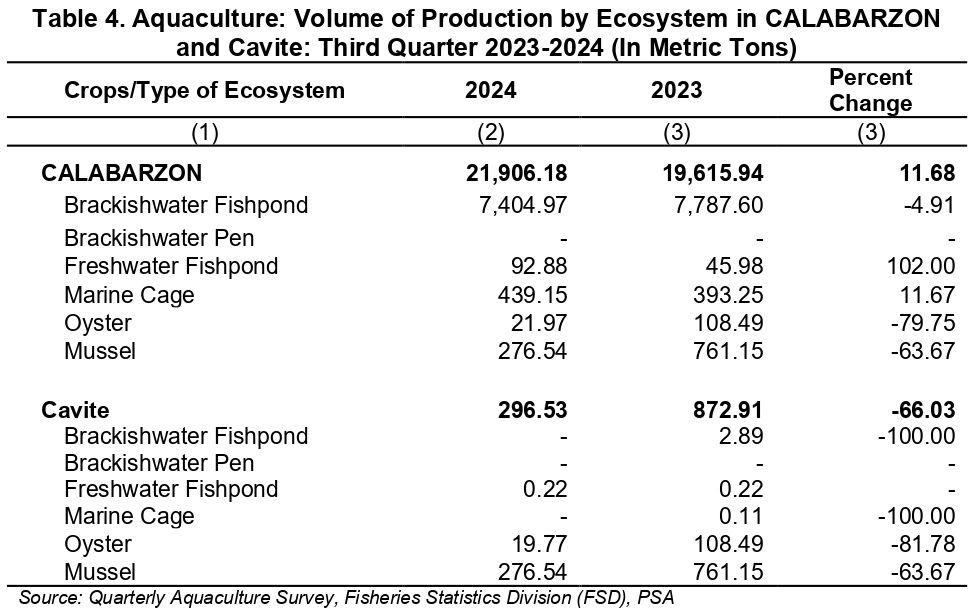
Value of Aquaculture Production
The total value of aquaculture production in CALABARZON reported at 2.44 billion pesos in the third quarter of 2024 which was 20.10 percent increase from 2.03 billion pesos in the same quarter last year. Harvests from brackishwater fishpond and freshwater fishpond were priced higher which increased its value to 31.46 percent and 199.54 percent, respectively. Meanwhile, other types of ecosystems had displayed lower values compared to the previous year’s coverage period.
In the province of Cavite, the value of aquaculture production went down at 64.23 percent, recorded at 11.37 million pesos in the third quarter of 2024 lower than 31.78 million pesos in the same quarter last year. This was observed in all types of aquafarms, which the freshwater fishpond values was dropped by 37.76 percent, and oyster declined at 61.05 percent. Also, mussel was valued at 10.25 million pesos showing 63.47 percent decrease compared to 28.06 million pesos of previous year’ third quarter. (Refer to Table 5 for details.)
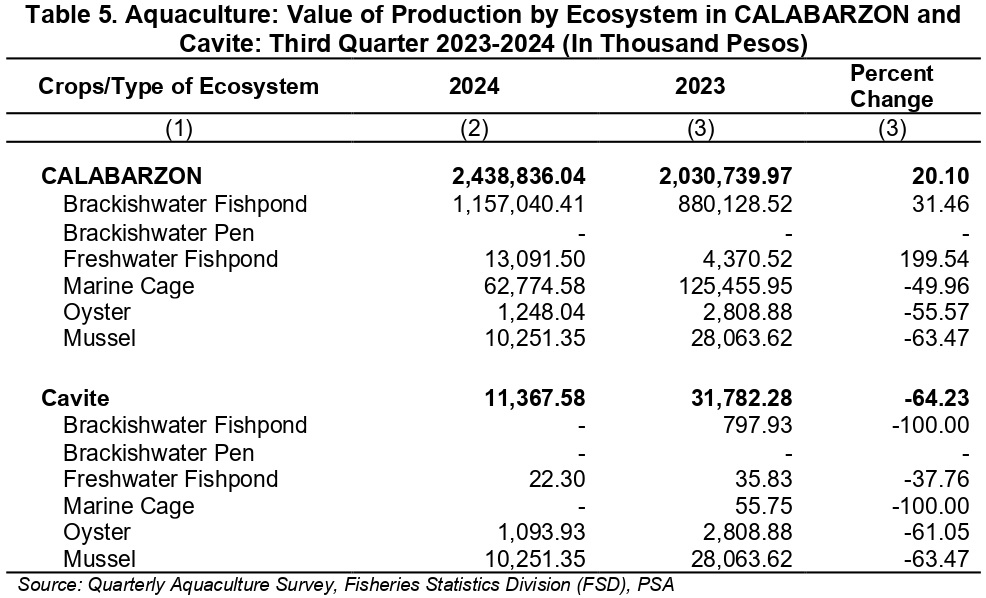
TECHNICAL NOTES
The Fisheries Situation Report is a quarterly publication by the Philippine Statistics Authority (PSA) that provides data on the volume and value of fisheries production. This report is based on four key surveys conducted by the PSA:
Quarterly Commercial Fisheries Survey (QCFS)
Quarterly Municipal Fisheries Survey (QMFS)
Quarterly Inland Fisheries Survey (QIFS), and
Quarterly Aquaculture Survey (QAqS)
These surveys are conducted quarterly, with reference periods as follows:
• First Quarter: January to March
• Second Quarter: April to June
• Third Quarter: July to September
• Fourth Quarter: October to December
Data collection method varies by survey:
• QCFS and QMFS: Data are gathered from sample fish landing centers on a monthly basis.
• QIFS: Data are collected from sample households engaged in inland fishing quarterly.
• QAqS: Data are obtained from sample aquafarms involved in aquaculture activities quarterly.
Definition of Terms
Fisheries – refer to all activities relating to the act or business of fishing, culturing, preserving, processing, marketing, deceloping, conserving, and managing aquatic resources and the fishery areas including the privilege to fish or take aquatic resources thereof (Republic Act No. 8550 otherwise known as “The Philippine Fisheries Code of 1998”).
Volume of Production – is the total weight in metric tons of the species from commercial, municipal, aquaculture and inland fisheries.
Value of Production – is the total price in thousand pesos of the species from commercial, municipal, aquaculture, and inland fisheries.
Quarterly Commercial Fisheries Survey – is a survey on volume and price of fish unloaded at sample commercial fish landing centers by fishing boats with gross tonnage of more than three (3) tons. Data on commercial fisheries are collected in fish landing centers where fishermen unload and trade their catch.
Quarterly Municipal Fisheries Survey – is a survey on volume and price of fish unloaded in municipal traditional fish landing centers by fishing boat with gross tonnage three (3) tons and less.
Quarterly Inland Fisheries Survey – is a survey on volume and price of fish, by species caught by the households engaged in inland fishing.
Quarterly Aquaculture Survey – is a quarterly survey that generates aquaculture production and area estimates. It asks for the actual level of production, area harvested and price for each species during the reference quarter of the current and previous year from the sample operators in the top producing municipalities.
Types of Ecosystems refers to the type of water environment where the various species were cultured.
Brackishwater Fishpond – a land-based type of aquafarm that utilizes a brackish water, mixture of seawater and freshwater for fish farming or aquaculture.
Brackishwater Pen – is an artificial enclosure constructed within a brackishwater for culturing fish and fishery/aquatic resources made up of bamboo poles closely arranged in an enclosure with wooden materials, screen, or nylon netting to prevent escape of fish.
Freshwater Fishpond – a land-based type of aquafarm; a pure fresh water where fish and other aquatic products are cultured, raised of cultivated under controlled conditions.
Marine Cage – a stationary or floating fish enclosure made of synthetic net wire/bamboo screen or other materials with or without cover with all sides either tied to poles staked to the water bottom or with anchored floats for aquaculture purposes.
Oyster – an aquafarm involved in the cultivation of oyster in shallow brackish or marine areas by any method for production purposes.
Mussel – an aquafarm involved in the cultivation of mussel in shallow brackish or marine areas by any method for production purposes.
For more details, please visit www.psa.gov.ph
